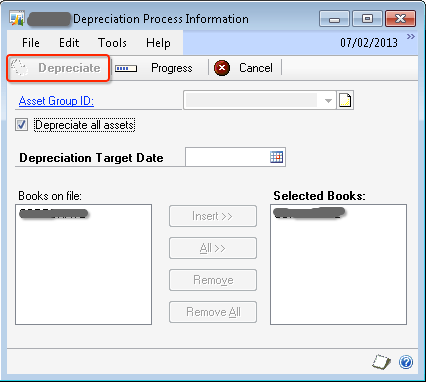This issue was a bit tricky but not THAT tricky, though.
One of the users reported to me that he was not able to run depreciation because when he opened the Depreciation Process Information window (Microsoft Dynamics GP -> Tools -> Routines -> Fixed Assets -> Depreciate), the Depreciate button was disabled. Below was the screenshot that he sent to me (disabled button is highlighted in RED box):
Reason: After quite a bit of analysis (Dex Script Log & SQL Profiling using SDT), I found that there is a table where FA module temporarily records the depreciation activity initiated by any user and will retain that record the process is complete.
User confirmed to me that last time when he ran the depreciation process, it got stuck at the time of printing the results.
Solution:
The table which records the activity is FA40203 (display name: Book Setup for Depreciation). The table contains three fields: User ID, FA Book Index & FA Book ID.
I took a backup of this table (a simple T-SQL SELECT * INTO…) and removed that stranded activity record for that user.
User confirmed that he could then start depreciation process.
Its always good to start a day with some brainy troubleshooting. But not certainly good for users to start with an issue, though.
VAIDY
